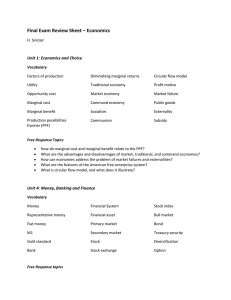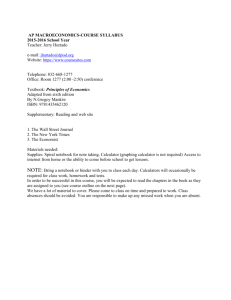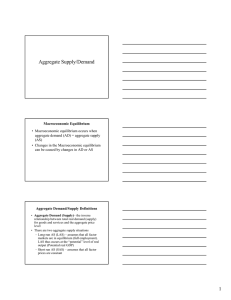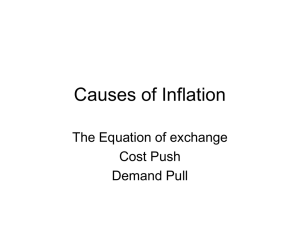The Disaggregated New Keynesian Phillips Curve Sandeep Mazumder
advertisement
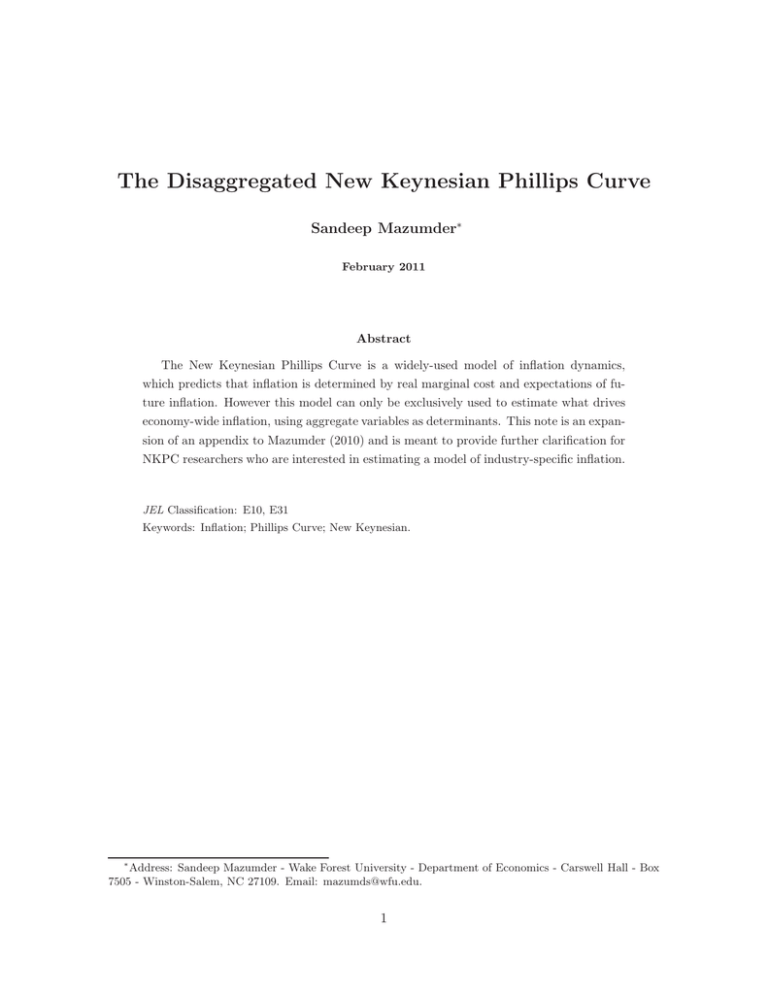
The Disaggregated New Keynesian Phillips Curve
Sandeep Mazumder∗
February 2011
Abstract
The New Keynesian Phillips Curve is a widely-used model of inflation dynamics,
which predicts that inflation is determined by real marginal cost and expectations of future inflation. However this model can only be exclusively used to estimate what drives
economy-wide inflation, using aggregate variables as determinants. This note is an expansion of an appendix to Mazumder (2010) and is meant to provide further clarification for
NKPC researchers who are interested in estimating a model of industry-specific inflation.
JEL Classification: E10, E31
Keywords: Inflation; Phillips Curve; New Keynesian.
Address: Sandeep Mazumder - Wake Forest University - Department of Economics - Carswell Hall - Box
7505 - Winston-Salem, NC 27109. Email: mazumds@wfu.edu.
∗
1
1
Introduction
The partial equilibrium, sticky-price New Keynesian Phillips Curve (NKPC) is a prominentlyused model of inflation dynamics, which states that economy-wide inflation depends positively
on real marginal cost and discounted expectations of future inflation. This model is popular among macroeconomists for several reasons. For example, the model is one which is a
macroeconomic relationship borne out of explicit micro-foundations, not to mention that the
model has several proponents when it comes to describing inflation empirically (such as Gali
and Gertler (1999)).
However the model can only be used to estimate aggregate inflation (defined as the percentage change in the aggregate price level), using an aggregate measure of real marginal
cost as the determinant. This leaves us with two important extensions to the model that
we are unable to test: first, we cannot examine industry-specific inflation in the traditional
NKPC, and second, it becomes difficult to use disaggregated measures of real marginal cost
in the model. This is problematic since there are many proxies for real marginal cost such as
capacity utilization, for which data is not available at the aggregate level.
Intuitively, there are also other strong reasons that we may wish to estimate a sectoral
NKPC. For example, we may have sectoral data that is of better quality than aggregate data,
or it may at least match the theoretical model counterparts better than the aggregate data.
In this case, a disaggregated NKPC can more precisely pin down the estimated structural
parameters of the model. In addition, there is clearly sectoral heterogeneity in price rigidity
which the aggregate NKPC does not account for, which a disaggregated model can instead
capture. Some authors have indeed attempted to derive this type of model, such as in Imbs,
Jondeau, and Pelgrin (2007). However they derive a NKPC equation that does not hold if
sectoral real marginal cost is deflated by an aggregate price index, which is an assumption
that many would consider to be unrealistic, particularly if we think aggregate prices will
affect nominal marginal cost in each sector. Other papers such as Leith and Malley (2007)
have also provided useful insights as to how a disaggregated NKPC could be derived, but we
argue that this note undertakes this process in a much simpler and more parsimonious way.
Upon deriving an industry-specific version of the NKPC, which is henceforth referred to
as the ‘disaggregated NKPC’, we find that this model turns out to be a generalization of the
traditional NKPC and is extremely useful for analysis of industry-level inflation (such as in
Mazumder (2010) who applies it to the U.S. manufacturing industry).
2
2
The NKPC
The three standard equations that we can use to derive the basic NKPC model are (see
Woodford (1996, 2003) and Goodfriend and King (1997) for explicit detail, and Mankiw and
Reis (2002) who use a similar setup to derive the NKPC):
p∗t = pt + mct
(1)
∞
X
qt = (1 − βθ)
(βθ)k Et p∗t+k
(2)
k=0
pt = (1 − θ)qt + θpt−1
(3)
where p∗t is the optimal profit-maximizing price, pt is the actual price level, mct is real
marginal cost, and qt is the firms’ adjustment price. Lower case variables represents logs,
where all three equations are log-linear approximations around a zero inflation steady state1 .
Also note that these are all aggregate-level variables. (1) states that a firm’s desired (or
profit-maximizing) price is the sum of the actual aggregate price level and some measure
of aggregate marginal cost (see Blanchard and Kiyotaki (1987) for further elaboration). (2)
states that the adjustment price for firms will be the weighted average of current and all
future optimal prices, where β is the discount factor for firms. Finally (3) is Calvo (1983)’s
notion of random price adjustment, which is obtained from expanding the pricing equation
P
j
of pt = (1 − θ) ∞
j=0 θ qt−j . Calvo’s equation states that in each period a certain fraction
of firms, (1 − θ), will adjust prices, and the remaining θ of the firms do not adjust prices
and continue to use the previous period’s price2 . Solving (1), (2), and (3) for a relationship
describing inflation, πt = pt − pt−1 gives the usual aggregate NKPC:
πt = λmct + βEt {πt+1 }
where λ =
3
(NKPC)
(1−θ)(1−βθ)
.
θ
The Disaggregated NKPC
To derive a disaggregated version of the NKPC, we must then ask whether (1), (2), and (3)
hold at the industry level. First, consider equation (2). This equation originally describes the
adjustment price which holds true for any given firm. Thus when we then aggregate across
all firms in the economy, we are left with (2). In other words, if this equation holds true for
1
2
Which is also why the markup does not appear in equation (1).
Note that other types of price stickiness can also be used to derive the NKPC, such as staggered contracts.
3
each firm, it will also hold true when we aggregate across all firms in one particular sector.
In other words, we can change all of the variables in (2) to sector-level ones.
The same can be said for (3), which holds true for any group of firms. According to
Calvo’s model of random price adjustment, we can assume that a fraction of firms in an
industry adjusts prices optimally in each period, while the remainder of the firms leave prices
unchanged from the previous period. Indeed, using Calvo-type pricing for multiple sectors is
often done, such as in Bils and Klenow (2004). Thus the variables in (3) can also be simply
changed into industry-specific ones.
However, (1) is not simply a matter of changing aggregate variables to disaggregated ones.
(1) comes from assuming Dixit-Stiglitz CES utility which gives us the result that optimal,
profit-maximizing price for a given firm j is a markup over nominal marginal cost:
∗
d
Pj,t
= µM
C j,t
(4)
d
where µ is the markup and M
C j,t is nominal marginal cost for firm j. When we then
aggregate (4) across all firms in the economy, convert into real terms, and set the log of the
markup equal to zero3 , we are left with (1). Now suppose that we instead aggregate across
all firms in a given industry, i. This gives firms in industry i an optimal price of:
i
d
(Pti )∗ = µM
Ct
where
P
i ∗
k (Pk,t )
= (Pti )∗ and
P
di
k (M C k,t )
(5)
i
d
= (M
C t ) for k firms in industry i. When we
now convert (5) into real terms we must divide by the aggregate price level, which leaves us
with
(Pti )∗
Pt
= µM C it , where we have real marginal cost, M Cti , on the right-hand side of the
equation. Once again, we then take logs and set the markup term equal to zero, leaving:
(pit )∗ = pt + mcit
(6)
which is the same as changing the variables in (1) to industry-specific ones, with the exception
of the aggregate price term, pt , which remains. Finally this leaves us with the three equations
we need to derive the disaggregated NKPC:
(pit )∗ = pt + mcit
qti
∞
X
= (1 − βθ)
(βθ)k Et (pit+k )∗
(I)
(II)
k=0
pit = (1 − θ)qti + θpit−1
3
Which is standard practice in the NKPC literature.
4
(III)
where (pit )∗ represents the industry’s desired price, pt is the aggregate price level, mcit is real
marginal cost in the given industry, qti is the adjustment price, and pit is the actual industry
average price. In other words, the disaggregated model is almost identical to the aggregate
one, except in (I) where the aggregate price level, pt , remains.
To solve for πti , we then break the sum in (2), take expectations at time t, and apply the
Law of Iterated Expectations to get an equation for qti . We can also get another equation
for qti by rearranging (III), which we also move forward by one period and take expectations
i . We can then use these equations, and some simple
at time t to get an equation for Et qt+1
algebraic manipulation to get an equation for industry-specific inflation, πti , as:
i
πti = λ[mcit + (pt − pit )] + βEt {πt+1
}
where λ =
(1−θ)(1−βθ)
θ
(Dis. NKPC)
as before. Clearly, we can observe that the disaggregated NKPC is
not quite the same as the aggregate NKPC due to the addition of the (pt − pit ) term. In
other words, the industry’s inflation rate is also dependent on the relative price between that
industry and the aggregate economy, as well as the usual NKPC variables.
Intuitively this is not surprising, since the aggregate price will affect nominal marginal
cost in each sector, and hence also affects the price charged in that given industry. In other
words, we expect the competition between industries to matter when considering inflation
within one particular sector. Furthermore, we can say that this disaggregated version of
the model is a generalization of the standard NKPC, since if we wish to examine aggregate
inflation we would set pit = pt , and are left with the usual NKPC equation.
4
Conclusion
The standard NKPC is a relationship that predicts how aggregate marginal cost determines
economy-wide prices. However this model cannot be used to examine industry-specific price
changes and cannot be used with industry-specific measures of marginal cost. This note
derives a disaggregated version of the NKPC which leaves us with a model that is a generalized
version of the standard NKPC, and is one that can be used to examine the issue of industryspecific inflation and its determinants.
References
Bils, M. and P. Klenow (2004): “Some Evidence on the Importance of Sticky Prices,”
Journal of Political Economy, 112, 947–985.
5
Blanchard, O. and N. Kiyotaki (1987): “Monopolistic Competition and the Effects of
Aggregate Demand,” American Economic Review, 77, 647–666.
Calvo, G. (1983): “Staggered Prices in a Utility Maximizing Framework,” Journal of Monetary Economics, 12, 383–398.
Gali, J. and M. Gertler (1999): “Inflation Dynamics: A Structural Econometric Analysis,” Journal of Monetary Economics, 44, 195–222.
Goodfriend, M. and R. King (1997): “The New Neoclassical Synthesis and the Role of
Monetary Policy,” NBER Macroeconomics Annual, 231–283.
Imbs, J., E. Jondeau, and F. Pelgrin (2007): “Aggregating Phillips Curves,” CEPR
Discussion Papers 6184, ECB.
Leith, C. and J. Malley (2007): “A Sectoral Analysis of Price-Setting Behavior in U.S.
Manufacturing Industries,” The Review of Economics and Statistics, 89, 335–342.
Mankiw, N. and R. Reis (2002): “Sticky Information Versus Sticky Price: A Proposal
to Replace the New Keynesian Phillips Curve,” Quarterly Journal of Economics, 117,
1295–1328.
Mazumder, S. (2010): “The New Keynesian Phillips Curve and the Cyclicality of Marginal
Cost,” Journal of Macroeconomics, 32, 747–765.
Woodford, M. (1996): “Control of the Public Debt: A Requirement for Price Stability?”
NBER Working Paper, 5684.
——— (2003): Interest and Prices: Foundations of a Theory of Monetary Policy, Princeton
University Press.
6

